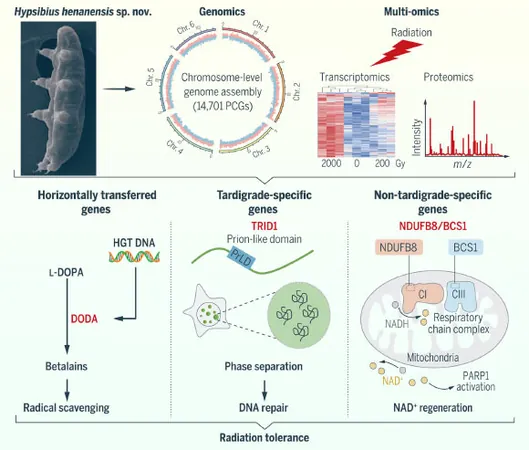
Discovering the Secrets of Tardigrades: How a New Species Reveals the Mysteries of Extreme Survival
2024-11-05
Author: Wei Ling
Scientists have recently unveiled groundbreaking insights into the remarkable radiotolerance of tardigrades, a newly discovered species called *Hypsibius henanensis*. This tiny creature, part of the unique group commonly known as water bears, is shedding light on the molecular mechanisms that enable these microscopic invertebrates to withstand extreme environmental conditions.
Tardigrades, first identified in 1773, are famous for their extraordinary resilience. These diminutive animals can survive for decades without food or water, endure temperatures as low as -272 degrees Celsius (-457 degrees Fahrenheit) and as high as 150 degrees Celsius (302 degrees Fahrenheit), and withstand enormous pressure variations—from the vacuum of space to the crushing depths of the Mariana Trench.
One of their most astonishing traits is their ability to endure extreme levels of ionizing radiation, withstanding doses that can reach 3,000 to 5,000 grays (Gy) while humans are lethally affected by a mere 3 to 5 Gy. Despite these well-documented capabilities, the specific mechanisms that allow tardigrades to thrive under such perilous conditions have remained somewhat enigmatic.
Previous research has suggested that tardigrades possess remarkable DNA repair systems and express a protein unique to their species, called damage suppressor (Dsup). This protein has been shown to protect human cells from radiation-induced DNA damage when expressed in those cells. However, the latest study led by Lei Li from Qingdao University dives deeper into the molecular nuances of these resilient organisms.
The researchers conducted extensive genome, transcriptome, and proteome analyses of *Hypsibius henanensis* and identified how exposure to heavy ion radiation affected the animal’s molecular makeup. They discovered that 285 stress-related genes were activated, unveiling three key mechanisms that contribute to the species' ability to resist radiation.
1. DOPA Dioxygenase 1 (DODA1) - This horizontally transferred bacterial gene enhances radiation resistance by producing betalains, pigments known for their effective free radical scavenging abilities typically found in plants and bacteria.
2. Tardigrade-Specific Protein TDP1 - This protein plays a critical role in repairing DNA double-strand breaks, which are particularly detrimental in the wake of radiation exposure.
3. Mitochondrial Chaperone Gene BCS1 - This gene has evolved uniquely within tardigrades and is specifically upregulated in response to radiation. It serves as a protector against mitochondrial damage caused by radiation, keeping the cell's energy powerhouse functioning efficiently.
According to the research team, "The extreme environmental resistance observed in extremophiles like tardigrades represents a treasure trove of unexplored molecular mechanisms of stress resistance.” They emphasize that further exploration into these radiotolerance pathways could illuminate new avenues for enhancing human health and developing innovative strategies to combat diseases.
This important research was published on October 25, 2024, in the esteemed journal **Science**, signaling a potential paradigm shift in biomedical applications inspired by these remarkable creatures.
As our understanding of tardigrades deepens, who knows what other secrets these seemingly invincible beings might hold? The world of extremophiles is bursting with secrets that could one day revolutionize how we approach human health in extreme environments!



 Brasil (PT)
Brasil (PT)
 Canada (EN)
Canada (EN)
 Chile (ES)
Chile (ES)
 España (ES)
España (ES)
 France (FR)
France (FR)
 Hong Kong (EN)
Hong Kong (EN)
 Italia (IT)
Italia (IT)
 日本 (JA)
日本 (JA)
 Magyarország (HU)
Magyarország (HU)
 Norge (NO)
Norge (NO)
 Polska (PL)
Polska (PL)
 Schweiz (DE)
Schweiz (DE)
 Singapore (EN)
Singapore (EN)
 Sverige (SV)
Sverige (SV)
 Suomi (FI)
Suomi (FI)
 Türkiye (TR)
Türkiye (TR)